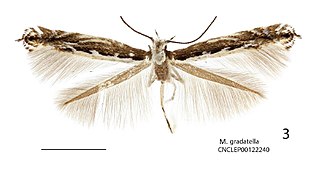Related Research Articles

Gracillariidae is an important family of insects in the order Lepidoptera and the principal family of leaf miners that includes several economic, horticultural or recently invasive pest species such as the horse-chestnut leaf miner, Cameraria ohridella.
Phyllonorycter apparella, the aspen leaf blotch miner moth, is a moth of the family Gracillariidae. It is found in most of Europe. It is also present in Turkey and North America.
Phyllonorycter trifoliella is a moth of the family Gracillariidae. It is known from Estonia, Georgia, Latvia, Lithuania and the Krasnodar Region of Russia.

Phyllonorycter insignitella is a moth of the family Gracillariidae. It is found in all of Europe, except the Balkan Peninsula.
Phyllonorycter nigrescentella is a moth of the family Gracillariidae. It is known from all of Europe except the Balkan Peninsula.
Phyllonorycter viciae is a moth of the family Gracillariidae. It can be found on Hokkaido island in Japan and in the Russian Far East.

Micrurapteryx gradatella is a moth of the family Gracillariidae. It is found from Fennoscandia to the Iberian Peninsula, the Alps and Romania and from Germany to central Russia, as well as in Tajikistan, the Urals, Siberia, and the Russian Far East.
Sauterina hofmanniella is a moth of the family Gracillariidae. It is found from Scandinavia to the Pyrenees, Sardinia, Italy and Romania and from France to central Russia.
Chrysaster ostensackenella is a moth of the family Gracillariidae. It is known from Ontario, Québec and Nova Scotia in Canada, and the United States. It has also been recorded in 2015 from China and in 2017 from Korea, and in 2022 from Central Italy.
Macrosaccus morrisella is a moth of the family Gracillariidae. In North America it is known from Manitoba, Ontario, and Quebec, south and west to Texas and Colorado.
Cameraria affinis is a moth of the family Gracillariidae. It is known from Quebec, Canada, and the United States.
Cameraria cincinnatiella is a moth of the family Gracillariidae. It is known from Ontario and Quebec in Canada, and the United States.
Cameraria quercivorella is a moth of the family Gracillariidae. It is known from Ontario, Quebec, and Nova Scotia in Canada and Kentucky, Florida, Georgia, Maine, Maryland, Michigan, New York, Texas, Vermont and Illinois in the United States.
Cameraria bethunella is a moth of the family Gracillariidae. It is known from Ontario and Quebec in Canada, and Illinois, Kentucky, Connecticut, Maine, New York and Texas in the United States.
Cameraria corylisella is a moth of the family Gracillariidae. It is known from Manitoba, Ontario, and Quebec in Canada, and Kentucky, Wisconsin, Maine, New York, Connecticut and Vermont in the United States.
Cameraria pentekes is a moth of the family Gracillariidae. It is known from British Columbia in Canada, and California and Washington in the United States.
Phyllonorycter memorabilis is a moth of the family Gracillariidae. It is known from California, United States.
Phyllonorycter fabaceaella is a moth of the family Gracillariidae. It is known from Tajikistan.
Micrurapteryx tortuosella is a moth of the family Gracillariidae. It is known from Kyrgyzstan and Tajikistan.

Micrurapteryx occulta is a moth of the family Gracillariidae. It is recorded from across North America in the northern half of the continent, in Canada from the Maritime Provinces to British Columbia, north to northernmost Yukon. In the United States it has been found in Connecticut, Kentucky, Illinois, Colorado, Utah, Nevada, and California. The habitat consists of meadows, the edge of forests, open ponderosa pine forests, alpine meadows, the sea shore, and probably other habitats, from sea level to high elevations in the mountains, where suitable hosts occur.
References
- ↑ Global Taxonomic Database of Gracillariidae (Lepidoptera)
- ↑ Gregory R. Pohl; Jean-François Landry; Christian Schmidt; et al. (2018). Annotated checklist of the moths and butterflies (Lepidoptera) of Canada and Alaska. ISBN 978-954-642-909-4. ISSN 1312-0174. OL 32898597M. Wikidata Q97158808.
{{cite book}}:|journal=ignored (help) - ↑ microleps.org